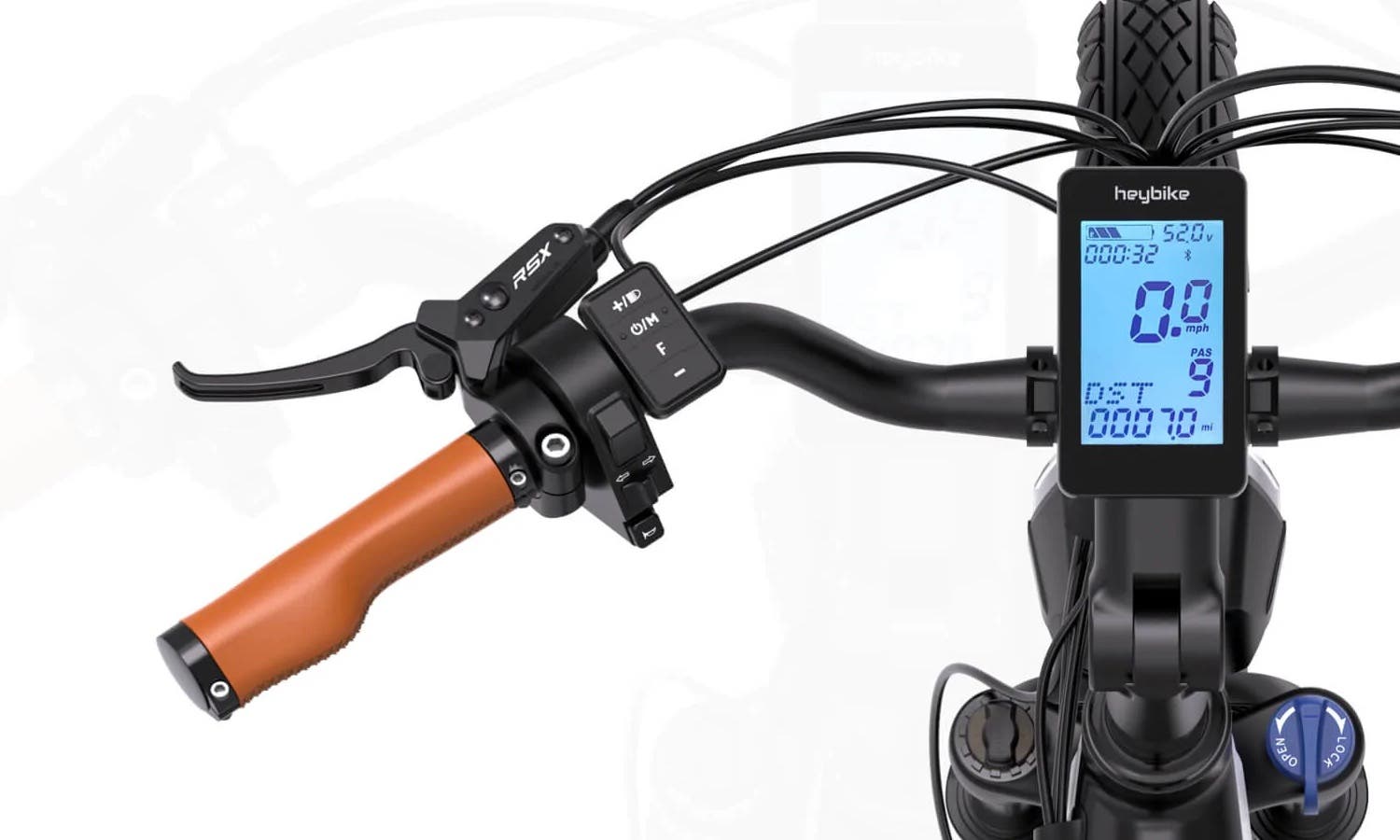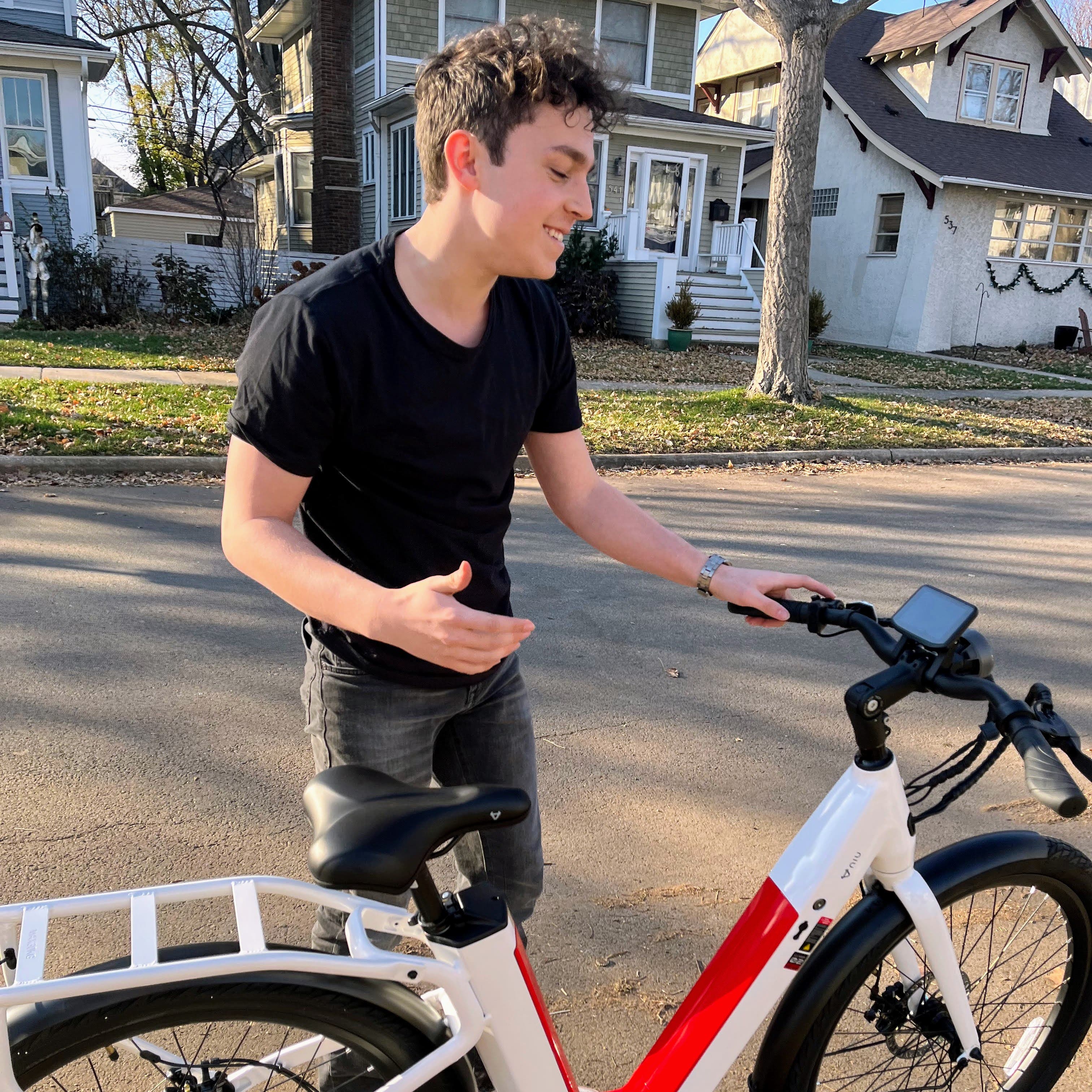With relatively low speed limits, bike lanes, and plenty of places to ride to, the near Western suburbs of Chicago offer a nearly perfect riding environment for modern e-bike riders, but what happens when two very different companies offer two very different e-bikes that each claim to be “ideal” for that one very same environment?
What happens is we get on some bikes and put them to the test!
The Players
NIU BQi-C3, Heybike CityRun; image by the author.
In this corner, weighing in at 67.5 pounds and packing not one but two energy-dense li-ion battery packs, is the high-tech and ultra-polished NIU BQi-C3 Pro e-bike.
Those two batteries add a bit of weight to the NIU BQi-C3, sure, but they’re neatly integrated into the bike’s frame in a highly contrasting red and white color motif that is highly reminiscent of the “cocaine over cherries” theme found in a number of 80s-era Gemballa Porsches. Because it’s from NIU, the electrical controls, throttle response, and connected app are all first-rate. The build quality, too, is first-rate, and the whole thing is put together with a level of fit and finish not commonly found at the NIU’s surprisingly low $1999 starting price.
In the other corner, though, there’s the $1299 Heybike Cityrun. Weighing in at 62 pounds and packing “just” one li-ion battery, the Cityrun is a value-priced, feature-heavy e-bike that, like the NIU, also offers a sharp, bicolore color scheme and a wallet-friendly starting price … but, beyond that?
Despite both bikes ostensibly being designed for everyday riding and practicality, the Heybike zigs where the NIU zags, adds features where the NIU adds build quality, and errs on the side of comfort where the NIU errs on the side of performance — and in the end, it was almost impossible to pick a winner.
Almost.
Zigs & Zags
As I’ve already mentioned a few times, these two bikes are built around very similar concepts. Both, for example, feature fairly upright, step-through frame designs with comfortable seats and handlebars. In the details, though, they’re very different.
If you consider a truly neutral seating position a “5,” a fully recumbent, relaxed position a “1,” and hunchbacked, weight on the wrists, Olympic track racer a “10,” then you could imagine that the people at Heybike went for a 4.5 seating position while NIU went for a 5.5. Which is to say that neither of the two bikes is uncomfortable — far from it, in fact. Still, the Heybike has a more elevated handlebar with a casual, longhorn-style bend that puts more weight on your butt and allows you to “hang” your arms from the handlebars in a way you just can’t on the NIU.
Meanwhile, the NIU’s flat handlebar sits at just about waist height, for me, giving it a sportier, more connected feeling at the e-bike’s (relatively) high speeds. Part of that road feel is the handlebar positioning and frame geometry, of course, but there’s another factor at play, as well. Namely, the NIU’s front suspension … because it doesn’t have one.
The Heybike’s hydraulic front suspension makes the bike ride more smoothly and more comfortably than the NIU, but it’s quite a bit more responsive than another favorite cruiser, the Trek-built Electra Townie, while not being any less comfortable. The seat on the Heybike is also a bit more padded than the NIU’s, but you shouldn’t take that to mean that the Heybike is soft where the NIU is hard. Oh no, dear reader — the truth is far stranger.
See, this isn’t just a case of the Heybike being the more relaxed choice, because the Cityrun comes equipped with a proper Shimano 7-speed trigger shifter and chain-driven derailleur for quick, decisive gear changes and solid, sporty feel. The NIU, meanwhile?
Despite its sportier riding position, the NIU makes do with a single gear ratio and a much smoother, quieter, carbon fiber reinforced drive belt from Gates. It’s a much less involved riding experience, from a power transmission point of view, and reminds me of that weird time in my life that I owned a manual transmission pickup truck and a Mustang with an automatic at the same time.
Out back, there’s more of the same sort of “zig and zag” happening, with the NIU’s integrated rear rack offering up to 30 kg (about 65 lb.) of load capacity. I couldn’t find an official weight rating on the Heybike, but the rack itself is a SOLID piece of kit, and I have zero doubt that the Cityrun’s 350 lb. carrying capacity is a conservative estimate.
Speaking of out back, while both bikes offer rear lights, there is one feature on the Heybike that really sets it apart from most of the e-bikes I’ve ridden and reviewed over the years: it has turn signals.
Real, Road-Ready Lighting Means Advantage: Heybike

Image courtesy Heybike.
It’s not just a matter of turn signals, either. The Heybike Cityrun features high and low-beam headlights that actually light the road ahead, which I can’t truly say about the NIU. What’s more, the motorcycle-style controls on the Cityrun offer more than just a functional brake light — the bright, LED turn signals are clearly visible from other cars, and offer a level of communication with the vehicle I share the road with that is simply a step above what NIU, Himiway, or even Specialized offer at significantly more money than the Heybike.
In short, if your number one priority is safety, and you’re the type of person who believes (quite rightly, I think) that the safest e-bike is the one that’s not in a crash, stop reading now. Buy the Heybike — you won’t regret it.
The Winner

The largest Borras offspring explains why he likes NIU’s e-bike best.
It’s just the little things, but — as the great Hank Scorpio said before he successfully seized East Coast — it’s the little things that make up life.
For a fit and finish nerd like me, there’s no contest here. The awkwardly named NIU BQi-C3 Pro is anything but awkwardly built. The shut lines around the battery covers are perfect, the welds clean, the fenders virtually invisible, the touch points premium — and that TFT display …

NIU full-color, TFT display; courtesy NIU.
… it’s just gorgeous, and easily visible any time, day or night. Combine that baked-in quality with the same, excellent NIU mobility app we talked about when we reviewed the electric scooter a few months ago, it’s simply no contest. The NIU is a better e-bike than the Heybike.
Then again, for fully 50% more money than the Heybike, It had better be!
Original content from CleanTechnica.

Read the full article here


